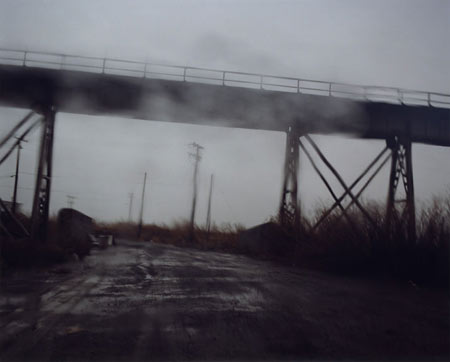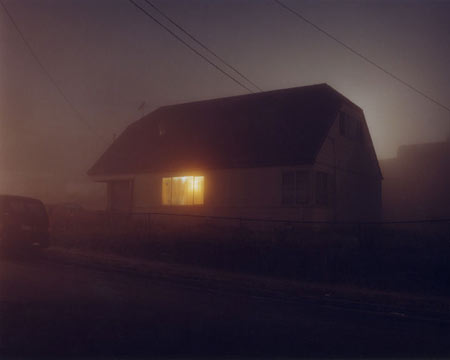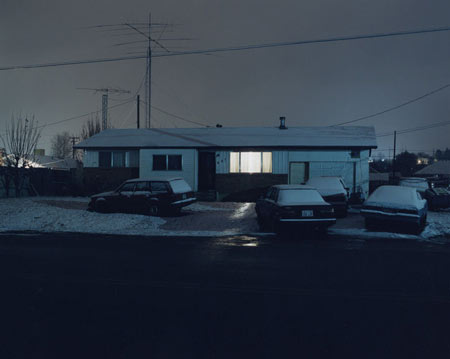A conversation with Todd Hido

Todd Hido might be mostly known for his eerie night-time scenes of anonymous suburban settings, but has also done portraits. In fact, he is one of the photographers whose work will be shown in A New American Portrait. I talked with Todd about his work, and about how to shoot a great portrait.
Jörg Colberg: What strikes me about your photography is the way you work with light. Your portfolio contains many images, especially the landscapes or interiors devoid of any people, which at least in part are a bit unsettling because of the lurking darkness and the often extremely bright windows or TV sets. How did you arrive at this kind of aesthetic?
Todd Hido: It really happened from just driving around and responding to light. Most of the time when am driving around I shoot places that are very “lit up” or are actually the source of light itself — I’ll shoot right into the sun or streetlight quite often. Then in the darkroom I take the other half of the process to where it ends up.
I still use film and traditional C-printing. I do the first prints of a negative myself in the darkroom for almost everything. I shoot sort of like a documentarian but I print like a painter. All my stuff is shot with natural light on a tripod. Untouched, and unstaged—with the exception of the portraits that are all staged to a point—but still are made using natural light in a fairly undirected way. In the darkroom I’ll twist it all around in anyway I find that works that still feels real to me. It is important for me that whatever I come up with always seems like it actually could have happened.

JC: I never talk much about technique, and I often get emails where people wonder why I don’t do that. I think this is actually a good opportunity to address a technical issue: Why film? What are the advantages of film for you? Why not digital?
TH: I still use color negative film and traditional C-printing. I do the first prints myself in the darkroom for almost everything. My 30” or larger prints are made by a lab in San Francisco called Lightwaves. Jennifer Key, a printer there, has the finely tuned skill of being able to match my smaller prints but in a larger version. I have used them for exclusively 12 years now and I find that having a solid relationship with one place has really been important.
There are some assignments that I shoot digital for. I am very open to it but I have found to get my images to have my look to them the best way to do this is to do it the way I have always done it.
For my fine art work—my books and gallery shows—I will continue to stick to the old school way of doing it. My process is not broken so there is not a need to fix it.
The digital process just cannot seem to represent the subtly of some of my prints. In fact I have noticed a real “relaxing of quality” out in the world due to people accepting and adapting to lesser results. Digital is multi-faceted for sure—it works for lots of things—but it not necessarily always better.
One day I was listening to the musician Lauryn Hill and she said this thing that spoke to me regarding using analog vs. digital technology:
“I want to bring to the audience a real sound.
My musical history is a soulful one.
I was raised on live human sounds.
I can’t just have sound come from a synthesizer or a keyboard or a computer…
The human element needs to be there
I need human sounds.
That is why I get the organ straight out the church—
it’s just a little bit of out of tune you know?”

JC: I could imagine shooting all those night scenes in neighbourhoods some of which don’t look all that appealing at times must have been a bit more exciting than the actual scenery. Did you run into problems with people wondering what you were doing in the dark around their homes?
TH: One time some guy thought I was his girlfriend’s ex-husband. That was scary until he figured out I wasn’t! But I most often go unnoticed even though I am very careful to not look like I am “lurking”. However, I never ask permission as people would mostly say no. I have tried a couple of times when I first started but got rejected right off the bat.
I don’t know about where you live but where I am people don’t take too kindly to strangers knocking on the door either.
It is a very hard process making art to begin with—just finding the right place is hard enough and half the battle. Sometimes I’ll drive around for 5-6 hours to find just the right spot—and then you find it at midnight you can’t knock on the door and ask.
When I find it I just take it. I never ever stand in someone’s yard or on their property. The police have been called several times but after they “run me though the system” and find I am not a criminal they leave. I don’t shoot power plants or airports luckily.

JC: Coming to your portraits, they appear to be a logical continuation of your other work, with what looks like fairly cheap motel rooms and often naked or semi-naked models looking uneasily at the camera. Can you give me a bit of background on the series? How did you find your models? And how did you explain to them what you wanted to convey with the images?
TH: One model is an old girlfriend and one is my wife but with the rest there is no relationship other than working together to make an interesting image. I find many of the models online from these modeling web sites that are out there. Many are total “beginners” which I like as they are not so stuck in anyone way of presenting themselves.
At the beginning of a shoot I often show the person I am going to photograph some pictures I have taken that I feel work and really try to let the images show or say what I am after.
As an artist I have always felt that my task is not to create meaning but to charge the air so that meaning can occur.
In all my pictures of people or places I see something of myself. I see the same qualities or troubles that I faced growing up.
The root of my work comes from the aberrations of my childhood and how these become attractions in adulthood.
It is about an attempt to understand how we replay, and recreate our earlier lives over and over again.
To me it all fits into me going back and responding to my history. My memory.
There is that great quote by Milan Kundera—“Memory does not make films, it makes photographs.”
As I have said in an earlier interview with Darius Himes—and I’ll repeat it here as I feel it is important to understanding my thinking on my work—“To me it is no mystery that we can only photograph effectively what we are truly interested in or—maybe more importantly—are grappling with. Often unconsciously. Otherwise the photographs are merely about an idea or a concept—that stuff eventually falls flat for me—there must be something more, some emotional hook for it to really work for me.”
JC: So how then do you charge the air—if you can/want to give it away? What is it in the interaction with your models that creates this special tension—if we want to call it that —that which results in a good portrait?
TH: There is no secret I could give away. You charge the air by photographing the right person, allowing them be real, and by making a potent image. My images can say so much more than I can honestly.

JC: The $1,000,000 question about portraiture appears to be who holds the key to how the portrait turns out—the photographer or the model. What is your take on this? How much can you, as the photographer, influence how the photo turns out?
TH: That is a great question and an easy one to answer—I feel it is really always a collaboration.
This is how the process works for me—very often the first time I meet someone I photograph is when they come to the shoot. For the most part I have only seen images of them online and usually have not ever talked to them on the phone. It is all set up via internet and email. So I know nothing of who they actually are—only what they choose to let me see.
There is some discomfort in that for both of us and that is useful I think in capturing a good image.
I have shot many, many, more people {and places} than have ended up being represented in my work. That is the nature of photography I think—you shoot a lot more than you show. You shoot lots and narrow it down to the best ones.
A writer once figured out that I end up showing about .5% of the film I shoot. I am a ruthless editor of my own work.
Also I know that the great, great collaborator in much of this medium of freezing moments, expressions and gestures is chance—and the other great force is luck!
But of course, you choose what to put in front of or point your camera at.
With these portraits several of the models are wearing wigs and don’t even resemble themselves. So there is some “styling” done by me and certainly acting happening on their part.
As I mentioned before the portraits are the only thing that is “staged” in my body of work as I can’t get an image like this totally candidly. I usually find a location that works and ask the model to “please stand over here”, or “let’s try sitting over there” and I just see what happens.
In posing—I don’t have the sitters push anything—the smallest actions are so expressive and complete. The best, most sincere poses almost always come in between rolls—when I am busy changing the film and the model is unaware of herself—when she is not projecting an imaginary image of who she wants to be—or thinks we want her to be.

JC: I often hear that editing is one of the hardest bits about photography. You shoot hundreds of photos, and then you edit them down - I think that might be one of the most important skills for any photographer actually. How do you approach editing?
TH:I really enjoy editing—and it is a really important part for me. I shoot often with 2 camera’s and do black and white and color as well so there are often many different images to pick from just one scene. I print all that are “good” pictures and have them in my archive. I see this archive as “stacks” of images—of people and places—that I can pick from when putting together a book or a show.
When I go to put together something I usually do a selection and head to the copy shop and start to make a book out of color copies, often in my car in the parking lot. Even if I am just selecting for a new show on the wall I start with a book format. I feel that with a sequence of shots that roll out one by one—like in a book—you are forced to make some kind of sense out of it that way. It is kind of like a paper movie. Narrative is important to my work I think.
I often will initially select stuff from my stacks and be half-way there with a project and then I will shoot to “fill it out”. Editing often leads to much more focused shooting. My last two books came together in this way.
JC: And then, of course, to conclude, if you had to pick a single photo— one of yours or by someone else—to take to a deserted island which one would that be, and why would you pick it?

TH: That is the hardest question to answer! It changes daily.
If it was truly all I could look at forever it would be this snapshot that I recently took of my four and a half year old twins, Owen and Audrey, at our newfound local Northern California BMX track. This place is all old school dirt jumps just like I used to live on. I told my kids that I am gonna get a bike of my own again and blow their minds!
Why? This is the stuff I’d want to remember.
 By
By